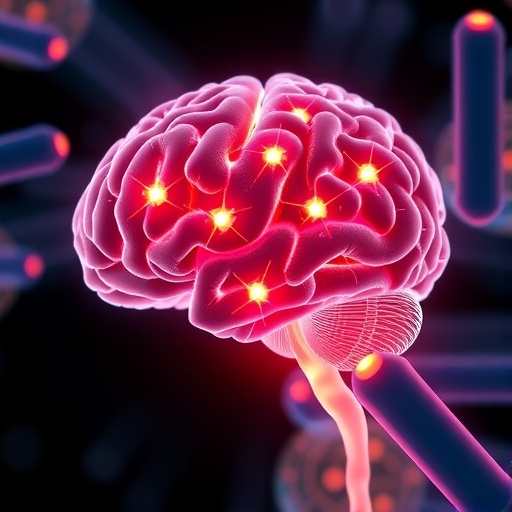In the rapidly evolving landscape of neuroscience and cellular biology, the quest to unravel the intricate role of mitochondria in brain health and disease has reached a groundbreaking milestone. Mitochondrial dysfunction is widely recognized as a pivotal factor underpinning a broad spectrum of neurological disorders, yet delineating a clear causal relationship has remained elusive. This is largely due to the absence of precise tools capable of selectively modulating mitochondrial activity within living organisms—tools that can provide a real-time window into the organelle’s contribution to neuronal function and neuropathology. Recently, an innovative approach spearheaded by Pagano Zottola and colleagues may finally bridge this critical gap, revealing a novel method to potentiate mitochondrial function and reverse cognitive deficits in mouse models of neurodegeneration. Their pioneering work, published in Nature Neuroscience (2025), harnesses designer molecular technology to selectively activate mitochondrial signaling pathways, thereby markedly enhancing bioenergetic output and rescuing memory impairment.
Central to this novel strategy is the deployment of a mitochondria-targeted recombinant receptor known as mitoDREADD-G_s, an engineered designer receptor exclusively activated by designer drugs (DREADD) specific to the stimulatory heterotrimeric G protein, G_s. These G proteins are quintessential molecular switches that regulate myriad cellular processes, acting as intermediaries to propagate signals from extracellular stimuli to intracellular effectors. Importantly, the presence of G protein signaling machinery within mitochondria themselves has been corroborated, opening intriguing possibilities for direct modulation of mitochondrial function. By designing a receptor construct tethered selectively to the mitochondrial membrane, the researchers successfully created a molecular tool capable of inducing mitochondrial G_s activation on demand, using an orthogonal activating ligand that does not interfere with endogenous receptors.
The underlying concept is both elegant and profound. G_s signaling is known to couple to adenylyl cyclase pathways and is linked to elevation of cyclic adenosine monophosphate (cAMP), a second messenger intimately involved in modulating mitochondrial metabolism, including enhancing membrane potential and oxygen consumption. Mitochondrial membrane potential is a crucial indicator of the organelle’s capacity to generate adenosine triphosphate (ATP), the cell’s energy currency. By acutely stimulating G_s activity within the mitochondria, mitoDREADD-G_s effectively boosts this bioenergetic metric, providing neurons with an immediate surge in mitochondrial energy output. Such targeted modulation holds the promise of compensating for deficits arising from compromised mitochondrial function, which is a hallmark of many neurodegenerative conditions.
.adsslot_rzwaPpRs1j{ width:728px !important; height:90px !important; }
@media (max-width:1199px) { .adsslot_rzwaPpRs1j{ width:468px !important; height:60px !important; } }
@media (max-width:767px) { .adsslot_rzwaPpRs1j{ width:320px !important; height:50px !important; } }
ADVERTISEMENT
In a series of meticulously designed experiments, the team demonstrated that mitoDREADD-G_s activation sharply increased mitochondrial membrane potential and raised rates of oxygen consumption in vitro, confirming the receptor’s potent effect on mitochondrial function. These findings are remarkable in that they establish not only the capability to enhance mitochondrial metabolism selectively but also the mechanistic link between G_s signaling inside mitochondria and energy production. These insights provide compelling evidence supporting a causative role of mitochondrial bioenergetics in sustaining neuronal health and cognitive function.
Translating these cellular findings into living organisms, the researchers proceeded to test whether mitoDREADD-G_s activation could ameliorate memory impairments in vivo. They focused on pharmacologically induced cognitive deficits evoked by cannabinoids, which have well-documented effects on learning and memory. Remarkably, mice expressing mitoDREADD-G_s and treated with the activating ligand displayed a complete reversal of cannabinoid-induced memory alterations, underscoring the therapeutic potential of mitochondrial potentiation in restoring impaired neural circuits. This result alone holds significant promise for addressing memory disruptions observed in a range of neurological contexts.
Pushing the boundaries further, the study evaluated the efficacy of mitoDREADD-G_s in two genetically engineered mouse models that recapitulate hallmarks of Alzheimer’s disease (AD) and frontotemporal dementia (FTD), two devastating neurodegenerative disorders lacking definitive cures. Both models exhibited conspicuous cognitive deficits alongside mitochondrial dysfunction, mirroring key pathological features observed in human patients. Activation of mitoDREADD-G_s in these models not only restored mitochondrial function but also reversed memory deficits, suggesting that enhancing mitochondrial signaling can counteract the complex synaptic and neuronal impairments characteristic of these disorders.
The implications of these findings are manifold and profound. From a mechanistic standpoint, this work provides the first direct evidence that selective modulation of mitochondrial G protein signaling can increase cellular bioenergetics and thereby preserve higher-order cognitive processes. This challenges existing paradigms that view mitochondrial damage merely as a downstream consequence of neurodegeneration and instead positions mitochondrial dysfunction as a critical, modifiable driver of disease progression. It also validates the concept that acute, reversible enhancement of mitochondrial metabolism could be harnessed therapeutically to mitigate cognitive decline.
Furthermore, the mitoDREADD-G_s system introduces a versatile platform for probing mitochondrial contributions in diverse biological processes and disease models. The ability to fine-tune mitochondrial activity with spatial and temporal precision opens new avenues for dissecting the causal relationships between mitochondrial health and cellular function, which have remained largely inaccessible until now. It also offers a powerful experimental framework to test the efficacy of mitochondrial-targeted interventions in preclinical settings.
Beyond the immediate realm of neurodegeneration, the potential applications of mitoDREADD-G_s extend to other brain disorders and systemic diseases linked to mitochondrial impairment. Conditions such as Parkinson’s disease, Huntington’s disease, stroke, and even metabolic syndromes impacting the brain could benefit from strategies aimed at boosting mitochondrial efficiency. Given the centrality of mitochondrial dysregulation in aging, such interventions might also contribute to cognitive preservation in healthy aging populations.
Technically, the success of mitoDREADD-G_s hinges on precise mitochondrial targeting of the receptor and the specificity of the activating ligand. This ensures that systemic activation does not elicit off-target effects, a common concern in drug development. The reliance on G_s-mediated signaling leverages highly conserved and well-characterized biochemical pathways, which likely facilitates translational adaptability. Moreover, the rapid onset of mitochondrial potentiation suggests that this approach could complement traditional therapeutic modalities, providing an acute boost to energy metabolism during critical windows of disease progression.
Critically, the study opens intriguing questions regarding the downstream molecular cascades triggered by mitochondrial G_s activation. While elevation of cAMP and membrane potential are immediate effects, the long-term impact on mitochondrial dynamics, reactive oxygen species generation, and mitophagy requires further elucidation. Understanding these processes is essential to optimize the therapeutic window and minimize potential adverse effects of enhanced mitochondrial activity, such as oxidative stress.
In synthesis, the work by Pagano Zottola et al. heralds a paradigm shift in mitochondrial biology and neurotherapeutics. By engineering a designer receptor activated exclusively within mitochondria, the researchers have crafted a sophisticated tool to manipulate organelle function with precision and temporal control. The compelling demonstration that this modulation can reverse pharmacological and pathological cognitive impairments in mice affirms mitochondria as accessible therapeutic targets and invigorates efforts to develop mitochondria-centric treatment strategies.
As the neuroscience community continues to grapple with the complexity of brain disorders, this study provides a shining beacon of innovation and hope. It invites a reevaluation of mitochondrial roles not only as energy producers but as pivotal signaling hubs influencing neuronal fate and circuit integrity. Future work expanding this technology across different models and species will be crucial to charting a path towards clinical translation.
The mitoDREADD-G_s system underscores the power of synthetic biology and molecular engineering in addressing longstanding challenges in medicine. Its ability to dissect and remediate the bioenergetic basis of cognitive dysfunction introduces a new frontier in understanding and treating neurodegenerative diseases, potentially transforming patient outcomes. By harnessing the organelle once dubbed the “powerhouse of the cell,” this breakthrough exemplifies how precision modulation of intracellular signaling can rewrite the narrative of neurological health and disease.
Subject of Research:
Mitochondrial modulation through designer receptor technology to reverse cognitive impairments in neurodegenerative disease models.
Article Title:
Potentiation of mitochondrial function by mitoDREADD-G_s reverses pharmacological and neurodegenerative cognitive impairment in mice.
Article References:
Pagano Zottola, A.C., Martín-Jiménez, R., Lavanco, G. et al. Potentiation of mitochondrial function by mitoDREADD-G_s reverses pharmacological and neurodegenerative cognitive impairment in mice. Nat Neurosci (2025). https://doi.org/10.1038/s41593-025-02032-y
Image Credits:
AI Generated
Tags: advancements in neurological disorder treatmentsbioenergetic output enhancementdesigner receptors in cellular biologyenhancing mitochondrial function in neurodegenerationG protein signaling pathwaysinnovative approaches in neurosciencemitochondrial dysfunction and cognitive declinemitoDREADD-Gs technologyNeurodegenerative disease researchreal-time monitoring of mitochondriareversing memory impairment in miceselective modulation of mitochondrial activity





